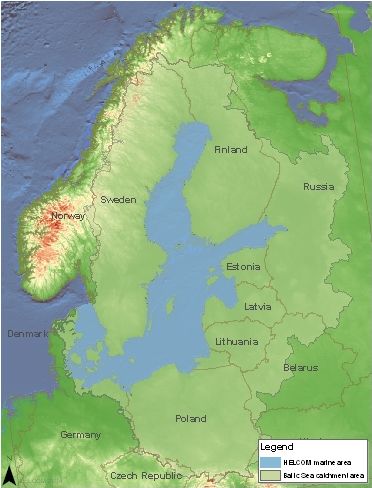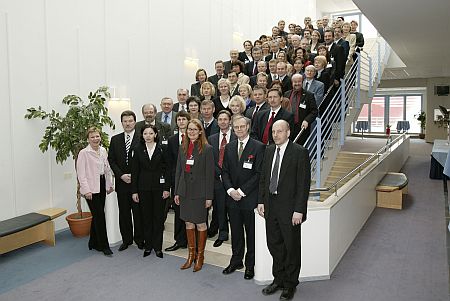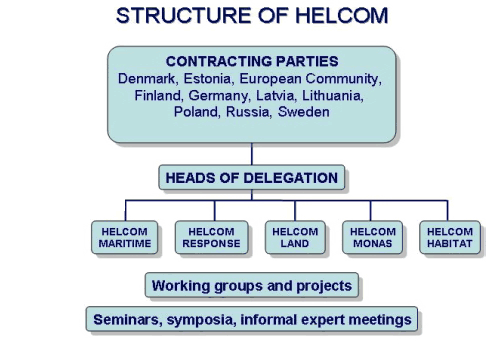About HELCOM

The Helsinki Commission, or HELCOM, works to protect the marine environment of the Baltic Sea from all sources of pollution through intergovernmental co-operation between Denmark, Estonia, the European Community, Finland, Germany, Latvia, Lithuania, Poland, Russia and Sweden.
HELCOM is the governing body of the "Convention on the Protection of the Marine Environment of the Baltic Sea Area" - more usually known as the Helsinki Convention.
HELCOM’s vision for the future is a healthy Baltic Sea environment with diverse biological components functioning in balance, resulting in a good ecological status and supporting a wide range of sustainable economic and social activities.
In pursuing this objective and vision the riparian countries have jointly pooled their efforts in HELCOM, which is works as:
- an environmental policy maker for the Baltic Sea area by developing common environmental objectives and actions;
- an environmental focal point providing information about (i) the state of/trends in the marine environment; (ii) the efficiency of measures to protect it and (iii) common initiatives and positions which can form the basis for decision-making in other international fora;
- a body for developing, according to the specific needs of the Baltic Sea, Recommendations of its own and Recommendations supplementary to measures imposed by other international organisations;
- a supervisory body dedicated to ensuring that HELCOM environmental standards are fully implemented by all parties throughout the Baltic Sea and its catchment area; and
- a co-ordinating body, ascertaining multilateral response in case of major maritime incidents.
For three decades HELCOM has been working to protect the marine environment of the Baltic Sea. This work has been driven by the specific environmental, economic and social situation in the Baltic region and the specific sensitivity of the Baltic Sea. The work of HELCOM has led to improvements in various fields, but further work is still needed.
Organisation Goals Principles Priorities Achievements
Organisation
The Helsinki Commission meets annually. Ministerial level meetings are also held occasionally. The Commission unanimously adopts Recommendations for the protection of the marine environment, which the governments of the Contracting Parties must act on in their respective national programmes and legislation.

The chairmanship of the Helsinki Commission rotates between the Contracting Parties every two years, according to their alphabetical order in English.
The working structure of HELCOM, supported by the Secretariat, consists of the meetings of the Helsinki Commission, the Heads of Delegation, and five main groups.

The Helsinki Commission is responsible for monitoring and implementing:
- The 1988 Ministerial Declaration, in particular concerning reaching the target of 50% reductions in nutrient inputs.
- The Baltic Sea Joint Comprehensive Environmental Action Programme (JCP) established in 1992 to facilitate and monitor the elimination of the 132 most polluting sources within the Baltic Sea catchment area - known as "hot spots".
The Goals of the Helsinki Commission
 HELCOM's main goal is to protect the marine environment of the Baltic Sea from all sources of pollution, and to restore and safeguard its ecological balance.
HELCOM's main goal is to protect the marine environment of the Baltic Sea from all sources of pollution, and to restore and safeguard its ecological balance.
The 1974 Convention
For the first time ever, all the sources of pollution around an entire sea were made subject to a single convention, signed in 1974 by the then seven Baltic coastal states. The 1974 Convention entered into force on 3 May 1980.
The 1992 Convention
In the light of political changes, and developments in international environmental and maritime law, a new Convention was signed in 1992 by all the states bordering on the Baltic Sea, and the European Community. After ratification the Convention entered into force on 17 January 2000. The Convention covers the whole of the Baltic Sea area, including inland waters as well as the water of the sea itself and the sea-bed. Measures are also taken in the whole catchment area of the Baltic Sea to reduce land-based pollution.
Principles
Responsibility
In order to restore the ecosystem of the Baltic Sea area and preserve its ecological balance the Contracting Parties shall individually or jointly take all appropriate legislative, administrative or other measures to prevent and eliminate pollution.
The precautionary principle
Preventive measures must be taken whenever there are reasonable grounds to believe that substances or energy directly or indirectly introduced into the marine environment might harm human health, living resources or marine ecosystems, or damage amenities or interfere with other legitimate uses of the sea.
Best Environmental Practices and Best Available Technologies will be promoted by the Contracting Parties to prevent the pollution of the Baltic Sea. Additional measures shall be taken if the consequent reductions of inputs do not lead to acceptable results.
The "polluter pays" principle should serve as the economic basis for the control of environmentally harmful activities, emphasising the importance of responsibility by forcing polluters to pay for the true costs of their activities.
Monitoring
Emissions from both point sources and diffuse sources into water and the air should be measured and calculated in a scientifically appropriate manner by the Contracting Parties.
Avoiding risks
Implementing the Helsinki Convention should neither result in transboundary pollution affecting regions outside the Baltic Sea area, nor involve increases or changes in waste disposal or other activities that could increase health risks. Any measures taken must not lead to unacceptable environmental strains on the atmosphere, soils, water bodies or groundwater.
Priorities
- eutrophication, especially the contribution of agriculture
- hazardous substances
- land transport sector
- maritime transport sector, including carrying out the Baltic Strategy
- environmental impacts of fishery management and practices
- protection and conservation of marine and coastal biodiversity
- implementation of the Joint Comprehensive Environmental Action Programme and HELCOM Recommendations
Achievements
Since the beginning of the 1980s the Helsinki Commission has been working to improve the Baltic marine environment, largely through some 200 HELCOM Recommendations.
Successes during this period include:
- Lower discharges of organic pollutants and nutrients from point-sources.
- A 20-25% overall reduction in the emissions of oxygen-consuming substances (BOD) from the 132 originally identified hot spots since the early 1990s, with about 50 hot spots deleted from the list.
- Fewer beaches closed for bathing, thanks to improvements in the treatment of industrial and municipal wastewater.
- Significant reductions in atmospheric nitrogen deposition.
- Dramatic reductions in emissions of organo-halogen compounds such as toxic dioxins and furans.
- National regulations banning hazardous substances like PCB and DDT.
- Stricter controls on industry (permits are now compulsory for industrial emissions).
- Improved joint monitoring of the state of the marine environment.
- The recovery of seal and white-tailed eagle populations.
- Better special legislation to prevent the pollution of the Baltic Sea by shipping, developed together with the International Maritime Organization (IMO).
- Measures to eliminate all illegal discharges by ships into the Baltic Sea.
- A major international plan to combat marine pollution, with active co-operation involving all the Contracting Parties through HELCOM.

